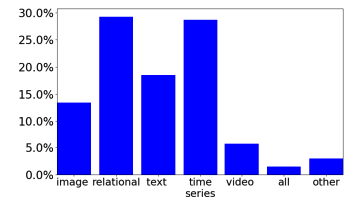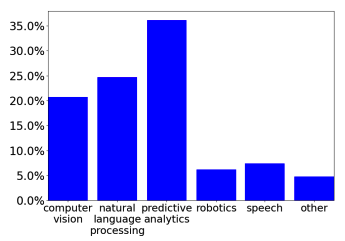We are extremely excited to explore the fascinating field of MLOps for Computer Vision.
Our objective is to create a flawless end-to-end pipeline by utilizing the most advanced MLOps tools out there.
By leveraging the potential of Machine Learning and Computer Vision, we understand the importance of establishing efficient and scalable procedures to deliver reliable and precise computer vision systems.
Come and join us on this enlightening expedition as we reveal the top techniques and tools for constructing a streamlined MLOps pipeline for Computer Vision.
Additionally, we are excited to mention that EasyFlow offers MLOps consulting services to support organizations in their journey towards building and optimizing their Computer Vision systems.


Key Takeaways
- MLOps is essential for maximizing the benefits of computer vision algorithms by ensuring efficient data management, model development, deployment, and error analysis.
- CVOps is a specialized branch of MLOps that focuses exclusively on computer vision projects, accelerating the development and deployment of reliable computer vision systems.
- The key components of CVOps include version control systems, automated testing and validation, continuous integration and deployment pipelines, monitoring and alerting mechanisms, and collaboration tools.
- Best practices for implementing CVOps include establishing clear and well-documented processes, implementing rigorous testing and validation, using containerization and continuous monitoring, and fostering a culture of collaboration.
Introduction to MLOps
MLOps plays a crucial role in computer vision projects by ensuring efficient data management, model development, deployment, and error analysis. It enables organizations to build and deploy reliable computer vision systems faster and at scale.
In March 2021, a survey found that 20% of data scientists focus on computer vision data in MLOps. Data management challenges, like messy or inaccessible data, were their main concerns.




Why is MLOps important for computer vision projects
MLOps provides an end-to-end pipeline for computer vision projects, encompassing various stages such as data collection, preprocessing, model development, and deployment.
By leveraging MLOps tools and best practices, we can automate the entire computer vision pipeline, ensuring smooth and reliable model development and deployment processes.
MLOps practices enable us to streamline the development and deployment of computer vision systems, improving efficiency and scalability.
With MLOps, we can effectively manage the complexities of computer vision projects, understand the nuances of model development, and ensure successful deployment of computer vision solutions in real-world scenarios.
MLOps is instrumental in maximizing the potential of computer vision technology and driving its widespread adoption across industries.
Understanding Computer Vision
Understanding Computer Vision is essential for developing accurate and efficient machine learning models for image analysis.
Computer Vision involves teaching machines to interpret and understand visual data, enabling them to recognize objects, detect patterns, and make informed decisions based on visual information.
The relationship between computer vision and machine learning
We have been exploring the intricate relationship between computer vision and machine learning, realizing how they work together to enable machines to see and understand images.
Computer vision involves the use of learning algorithms to process image-like input types, allowing machines to perceive and interpret visual information.
Machine learning, on the other hand, provides the underlying framework and techniques for training models that can effectively analyze and interpret the visual data.
In the context of MLOps, computer vision plays a crucial role in tasks such as data and feature management, dataset creation and preprocessing, model development, deployment, and operationalization.
Building an End-to-End Pipeline
When building an end-to-end pipeline for computer vision projects, it’s crucial to manage the dataset effectively. This includes tasks such as collecting, labeling, and preprocessing the data to ensure its quality and suitability for model training.
Additionally, model development and training play a vital role in building a successful pipeline, as they involve selecting appropriate algorithms, optimizing hyperparameters, and iteratively improving the model’s performance.
The key stages of an end-to-end pipeline
One of the key stages in building an end-to-end pipeline is ensuring efficient data management throughout the entire process.
In the context of computer vision models, MLOps plays a crucial role in deploying and managing these models effectively.
The workflow for building an end-to-end computer vision pipeline involves continuous integration, model training, and deploying the trained models.
MLOps provides best practices for each of these stages, ensuring that the models are developed and deployed in a reliable and efficient manner.
Continuous integration allows for seamless integration of new features and updates, while model training ensures that the models are trained on relevant and high-quality data.
Importance of dataset management in computer vision projects
Data management is crucial in computer vision projects, as it ensures the efficient organization and utilization of datasets.
In the context of end-to-end CVOps, dataset management plays a vital role in the ML training pipeline, enabling the automation of the pipeline and continuous training.
Effective dataset management involves collecting, storing, cleaning, labeling, and preprocessing large volumes of data for machine learning and deep learning algorithms.
It also includes ensuring data quality, version control, and data privacy. By managing datasets effectively, we can improve the accuracy and performance of computer vision models, leading to the operationalization of ML models in real-world computer vision applications.
Various tools and techniques are available to assist with dataset management, such as data version control systems, annotation tools, and data management platforms.
Table 1 provides an overview of the importance of dataset management in the end-to-end CVOps process.
| Importance of Dataset Management |
|---|
| Efficient organization of datasets |
| Data cleaning and preprocessing |
| Data quality assurance |
| Version control and reproducibility |
| Data privacy and security |
Model development and training for computer vision
We are currently discussing the process of developing and training models for computer vision, which involves building an end-to-end pipeline.
In model development, we focus on selecting and implementing appropriate algorithms and techniques to solve specific computer vision tasks.
Training the models requires a large amount of labeled data and involves optimizing parameters, adjusting hyperparameters, and using various training techniques such as transfer learning.
MLOps plays a crucial role in streamlining this process by providing tools and best practices for managing data, versioning models, automating deployment, and monitoring model performance.
An end-to-end pipeline ensures seamless integration between different stages of model development and training, allowing for iterative development and continuous improvement.
Best MLOps Tools for Computer Vision
When it comes to MLOps tools for computer vision, there are several options available that can streamline and enhance the development and deployment process.
Some of the best tools include:
- TensorFlow and PyTorch for model training
- TensorFlow Serving and ONNX Runtime for model deployment
- MLflow and Prometheus for monitoring and optimization
These tools offer a comprehensive solution for managing data, training models, deploying them into production, and monitoring their performance, enabling efficient and reliable computer vision systems.
Let’s discuss these tools in more detail and explore their features and benefits.
Overview of popular MLOps tools
One of the key aspects in our knowledge of MLOps is understanding the benefits and functionalities offered by popular MLOps tools for Computer Vision. MLOps for computer vision enables the building of an end-to-end pipeline, encompassing the development and deployment of computer vision systems. Implementing computer vision requires efficient processes and tools, and MLOps provides just that.
The best MLOps tools for computer vision offer a range of functionalities such as data and feature management, model training and deployment, and monitoring and optimization.
These tools ensure efficient data management, model development, deployment, and error analysis, enabling organizations to benefit from computer vision algorithms.
Data and feature management tools
There are several data and feature management tools available for computer vision projects, such as neptune.ai, Data Version Control (DVC), Roboflow, and Dataiku. These tools are essential for data scientists and machine learning engineers working with computer vision algorithms.
They provide an MLOps platform for building an integrated ML system and automating the ML pipeline.
The data and feature management tools help in managing the training pipeline, ensuring efficient data storage, version control, and collaboration. They play a crucial role in the development and deployment of computer vision systems, bringing reliable and accurate results.
With these tools, data scientists and machine learning engineers can streamline their workflow, improve productivity, and achieve better outcomes in their computer vision projects.
Model development and deployment tools
We have found that the best MLOps tools for computer vision provide efficient solutions for model development and deployment, revolutionizing the way we bring our computer vision projects to life. These tools enable us to seamlessly integrate machine learning into our computer vision tasks, creating a fusion of computer vision and machine learning.
Here are three sub-topics within model development and deployment tools:
1. Model Development:
- TensorFlow: A widely used open-source framework for building and training deep learning models.
- PyTorch: A popular deep learning library that offers dynamic computational graphs and a user-friendly interface.
- Keras: A high-level neural networks API that simplifies the process of building and training models.
2. Deployment Tools:
- TensorFlow Serving: A flexible serving system for deploying trained TensorFlow models in production.
- ONNX Runtime: An open-source runtime for executing ONNX models on various platforms.
- Amazon SageMaker: A fully managed service that simplifies the deployment of machine learning models on AWS.
3. End-to-End Pipeline:
- Kubeflow: An open-source platform that allows us to build and deploy portable ML workflows on Kubernetes.
- Azure Machine Learning: A cloud-based service that provides tools for training, deploying, and managing ML models.
- Gradient Services: A platform that offers end-to-end MLOps capabilities, including model development, deployment, and monitoring.
These tools streamline the process of developing and deploying computer vision models, enabling us to create robust end-to-end pipelines for our projects.
The vision enabled by these MLOps tools empowers us to tackle complex computer vision tasks with ease and efficiency.
Monitoring and automation tools
Utilizing monitoring and automation tools, we can continuously track and optimize the performance of our computer vision models in production. MLOps for computer vision is essential for building an end-to-end pipeline that ensures efficient deployment and continuous improvement.
To achieve this, we need the best MLOps tools, including monitoring tools and automation tools. These tools enable us to monitor the performance of our computer vision systems in real-time, identify any issues or anomalies, and take proactive measures for optimization.
With continuous integration and a continuous pipeline, we can ensure iterative development and deploy updated models seamlessly. By leveraging these tools, we can enhance the reliability and stability of our computer vision models, improving their efficiency and delivering high-quality results in a dynamic production environment.
Benefits of MLOps Integration
When it comes to integrating MLOps into computer vision projects, there are several benefits to consider.
Firstly, improved scalability and reproducibility allow for the efficient handling of large datasets and the ability to replicate results consistently.
Secondly, efficient collaboration between teams is facilitated, enabling seamless communication and coordination throughout the development and deployment process.
Lastly, by implementing MLOps, organizations can significantly reduce their time-to-market for computer vision solutions, accelerating the delivery of reliable and impactful systems.
Improved scalability and reproducibility
MLOps integration offers the benefits of improved scalability and reproducibility, ensuring efficient and reliable deployment of computer vision systems. This is crucial for ML engineers who want to streamline their workflows and optimize the ML lifecycle.
End-to-End Pipeline: MLOps enables the creation of a seamless end-to-end pipeline for computer vision projects, from data collection to model deployment, allowing for comprehensive management and automation of the entire process.
Best MLOps Tools: Implementing the best MLOps tools, such as Kubeflow, Azure Machine Learning, and Algorithmia MLOps Automation, can greatly enhance scalability and reproducibility in computer vision projects.
Continuous Integration: MLOps facilitates continuous integration, allowing for the integration of new features, bug fixes, and improvements into the computer vision system in a smooth and efficient manner.
Efficient collaboration between teams
Implementing MLOps integration allows us to achieve efficient collaboration between teams by improving communication and streamlining workflows.
In a machine learning project, where computer vision is involved, effective collaboration is crucial to successfully deploy computer vision systems into production.
MLOps for computer vision provides a framework for building an end-to-end pipeline that encompasses data management, model development, deployment, and monitoring.
By utilizing MLOps tools, such as CVOps, teams can ensure seamless collaboration and efficient coordination throughout the entire process.
MLOps enables teams to work together, share insights, and make informed decisions, ultimately leading to faster deployment, improved reliability, and better control over computer vision systems.
With MLOps, teams can leverage the power of collaboration to drive successful outcomes in machine learning projects involving computer vision.
Reduced time-to-market for computer vision solutions
How can we achieve reduced time-to-market for computer vision solutions by integrating MLOps?
Integrating MLOps into the development process of computer vision solutions is crucial for achieving reduced time-to-market. By building an end-to-end pipeline with the best MLOps tools, we can streamline and automate various stages of the development cycle.
- Efficient data management: Implementing robust data collection, storage, and preprocessing techniques ensures high-quality input for training and evaluation. Tools like neptune.ai and Data Version Control (DVC) can aid in data and feature management.
- Seamless model development: Leveraging popular frameworks such as TensorFlow and PyTorch enables efficient model training and deployment. Tools like TensorFlow Serving and ONNX Runtime facilitate the deployment process.
- Continuous monitoring and optimization: Monitoring tools like TensorBoard and MLflow help track model performance in production. Optimization tools like AutoML and Hyperopt aid in improving the model over time.
CVOps: The Fusion of Computer Vision and MLOps
Since we have been discussing the fusion of Computer Vision and MLOps, it is important to understand how CVOps combines the processes and tools of both fields to develop and deploy efficient computer vision systems.
CVOps, or Computer Vision Operations, leverages the best practices and tools from MLOps to build an end-to-end pipeline for computer vision projects. By integrating data and feature management, model development, and operationalization, CVOps ensures efficient deployment and continuous improvement of computer vision systems.
To engage the audience, here is a table showcasing some of the best MLOps tools commonly used in CVOps:
| Stage | Tools | Description |
|---|---|---|
| Data Management | Data Version Control | Enables versioning and collaboration for large datasets |
| Model Development | TensorFlow | An open-source ML framework widely used for computer vision tasks |
| Operationalization | BentoML | A platform for packaging and deploying ML models as APIs |
CVOps combines the power of MLOps and computer vision to streamline the development and deployment process, enabling organizations to build efficient and reliable computer vision systems.
Frequently Asked Questions
Are There Any Specific Challenges or Limitations in Implementing MLOps for Computer Vision Projects?
There are specific challenges and limitations in implementing MLOps for computer vision projects. These include managing complexity and diversity of CV models, ensuring data privacy and security, dealing with computational requirements and resource constraints, and adapting to changing business requirements.
What Are Some Commonly Used Tools or Platforms for Data and Feature Management in Cvops?
Some commonly used tools or platforms for data and feature management in CVOps include neptune.ai, Data Version Control (DVC), Roboflow, and Dataiku. These tools help ensure efficient handling and organization of data in computer vision projects.
How Does CVOps Accelerate the Development and Deployment of Computer Vision Systems Compared to Traditional Approaches?
CVops accelerates development and deployment of computer vision systems by leveraging MLOps processes. It ensures efficient data and feature management, model development, automated pipelines, and continuous monitoring. This results in faster iteration, enhanced reliability, and seamless integration.
How Does MLOps Differ From Devops in Terms of Key Components and Processes?
MLOps differs from DevOps in key components and processes. MLOps emphasizes code versioning, compute environment, continuous integration/delivery, monitoring in production, and data provenance to address the specific challenges of deploying and managing machine learning models.
What is MLOps for Computer Vision?
MLOps for Computer Vision is the practice of applying the principles and techniques of MLOps (Machine Learning Operations) specifically to computer vision projects. It involves building an end-to-end pipeline using the best MLOps tools and techniques to streamline and automate the development, deployment, and monitoring of computer vision models.
How is MLOps for Computer Vision different from traditional MLOps?
MLOps for Computer Vision focuses on the unique challenges and requirements of computer vision projects. It involves working with tabular data, natural language processing, and other specialized techniques that are exclusive to computer vision. The automated ML pipeline in MLOps for Computer Vision is specifically designed to handle the steps and processes of computer vision models.
How is MLOps for Computer Vision called?
MLOps for Computer Vision is often referred to as “CVOps” (Computer Vision Operations). It is a specialized branch of MLOps that focuses on the unique challenges and requirements of computer vision projects.
How does computer vision enable machines?
Computer vision enables machines to “see” and interpret visual data, just like humans do. By using algorithms and models, computer vision systems can analyze images or video streams, extract valuable information from them, and make intelligent decisions based on that information.
How can MLOps help in building an end-to-end pipeline for computer vision projects?
MLOps provides the necessary tools and practices to automate the pipeline of developing, deploying, and managing computer vision models. It enables the seamless integration of various stages, such as data preprocessing, model training, evaluation, and deployment, ensuring that the pipeline is efficient, reliable, and scalable.
Can MLOps be exclusive to computer vision?
Yes, certain aspects of MLOps can be exclusive to computer vision due to the unique characteristics of visual data. For example, preprocessing techniques, model architectures, and performance evaluation methods may be specific to computer vision applications. However, many principles and practices of MLOps are applicable across different domains.
How can MLOps and computer vision be fused together?
The fusion of MLOps and computer vision, often referred to as “CVOps,” involves incorporating MLOps tools and practices into the development and deployment of computer vision models. By combining the best practices of both domains, organizations can build and manage scalable computer vision systems efficiently.
What are the specific processes of MLOps exclusive to computer vision?
Some of the processes in MLOps that are exclusive to computer vision include data augmentation for image datasets, model interpretation techniques specific to visual data, and anomaly detection in computer vision models. These processes address the unique challenges and requirements of handling visual data in MLOps.
Conclusion
In conclusion, implementing MLOps for computer vision has proven to be a game-changer in terms of efficiency and reliability.
The seamless integration of machine learning models into production environments, coupled with the power of computer vision, allows for the development of accurate and scalable systems.
By leveraging the best MLOps tools and services available, such as EasyFlow which also offers MLOps consulting services, we can build an end-to-end pipeline that ensures the smooth management of data, features, models, and operations.
This revolutionary approach revolutionizes the field of computer vision, taking it to new heights of performance and innovation.
Curious About The Above Solution?
Chat with Vejūnė and explore your possibilities without any commitment.


Vėjūnė Krašinskienė
Chief Operating Officer
Book a no-obligation free consultation with our expert.


